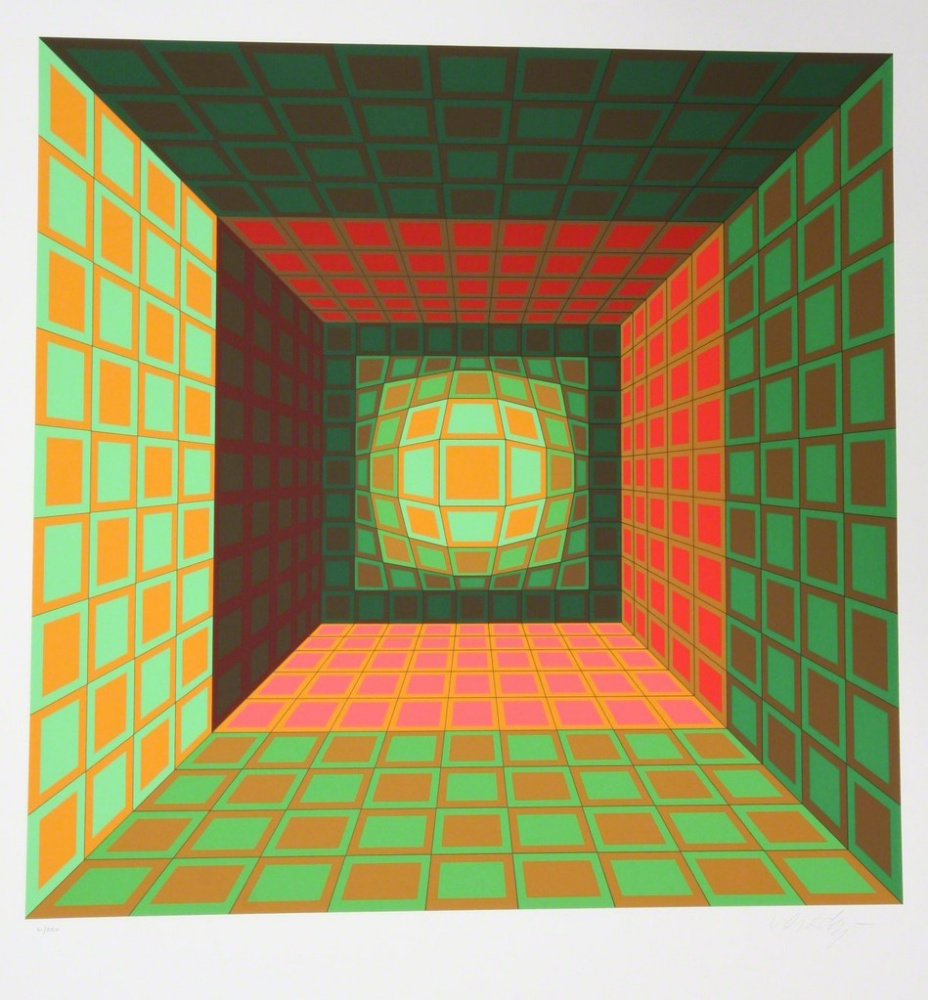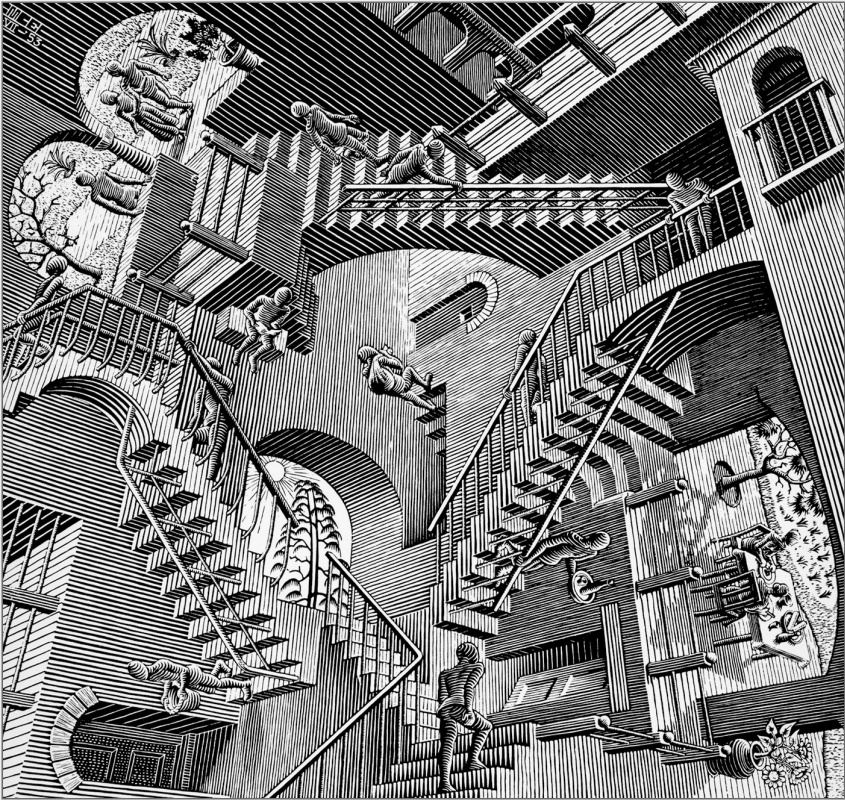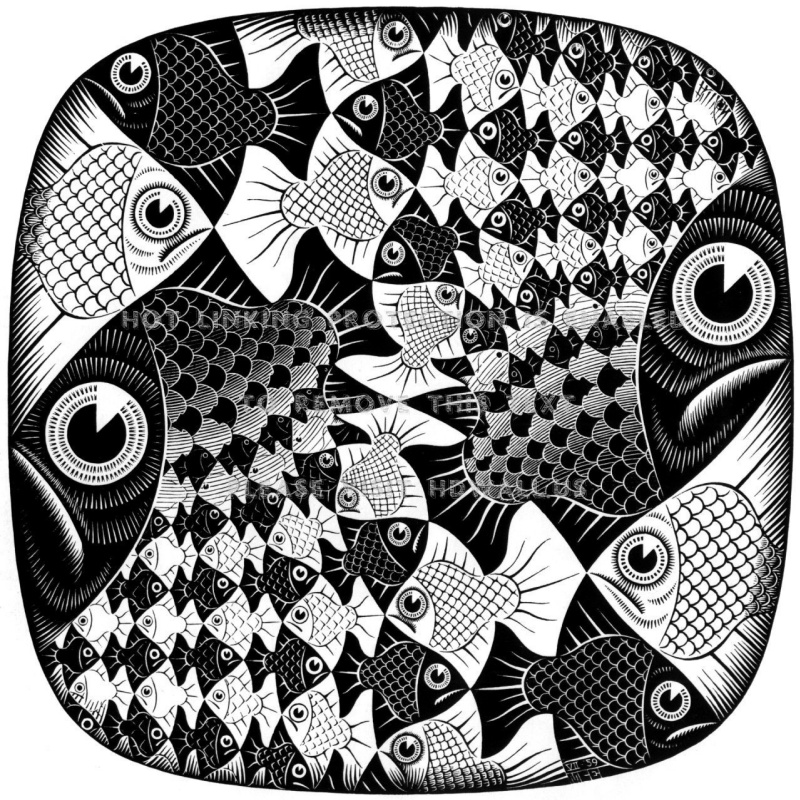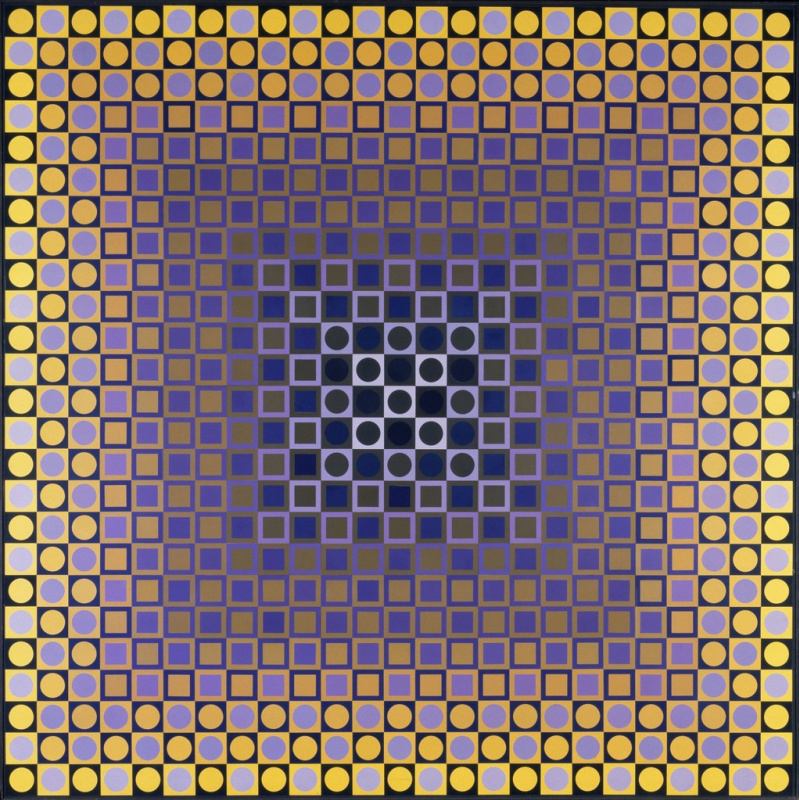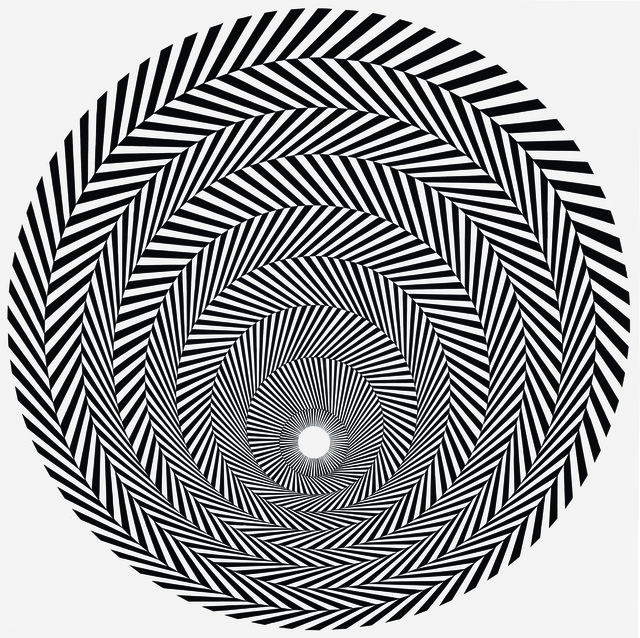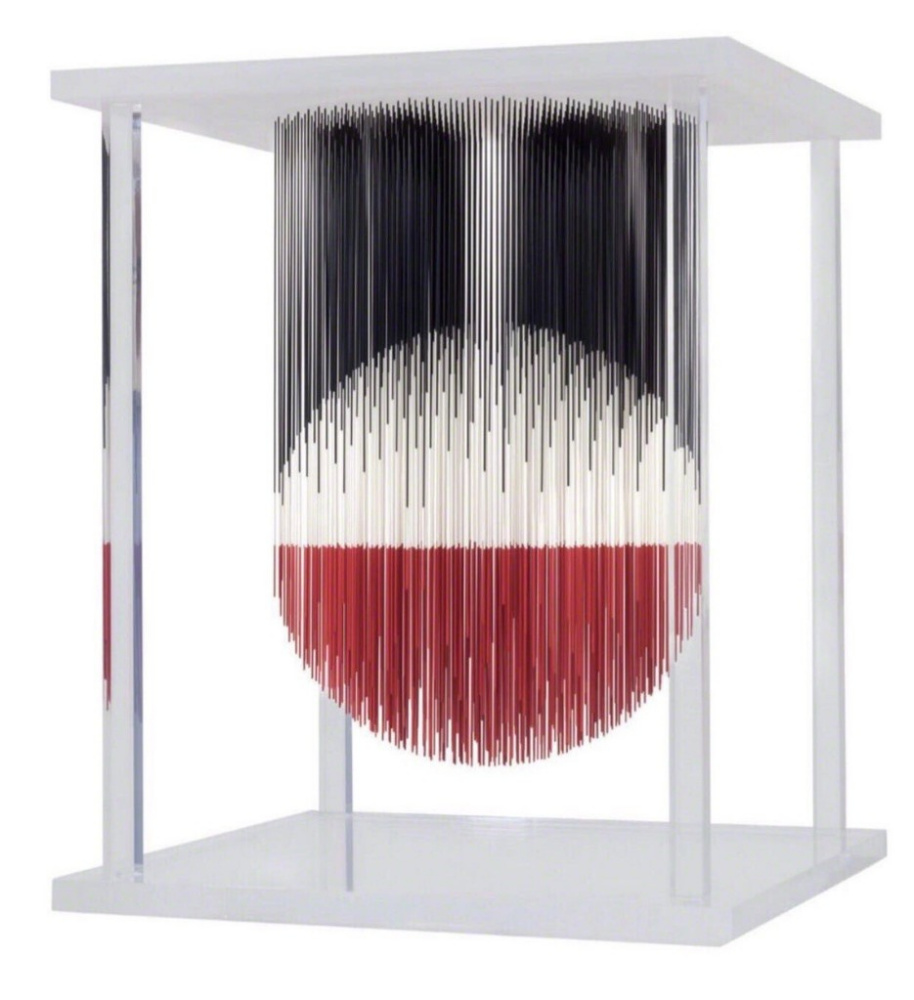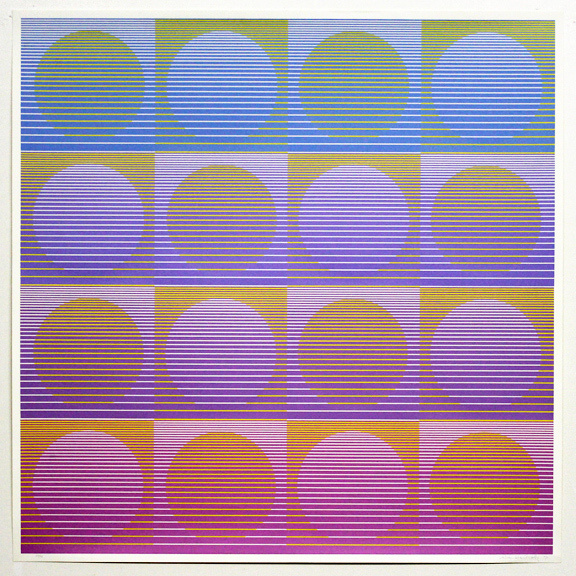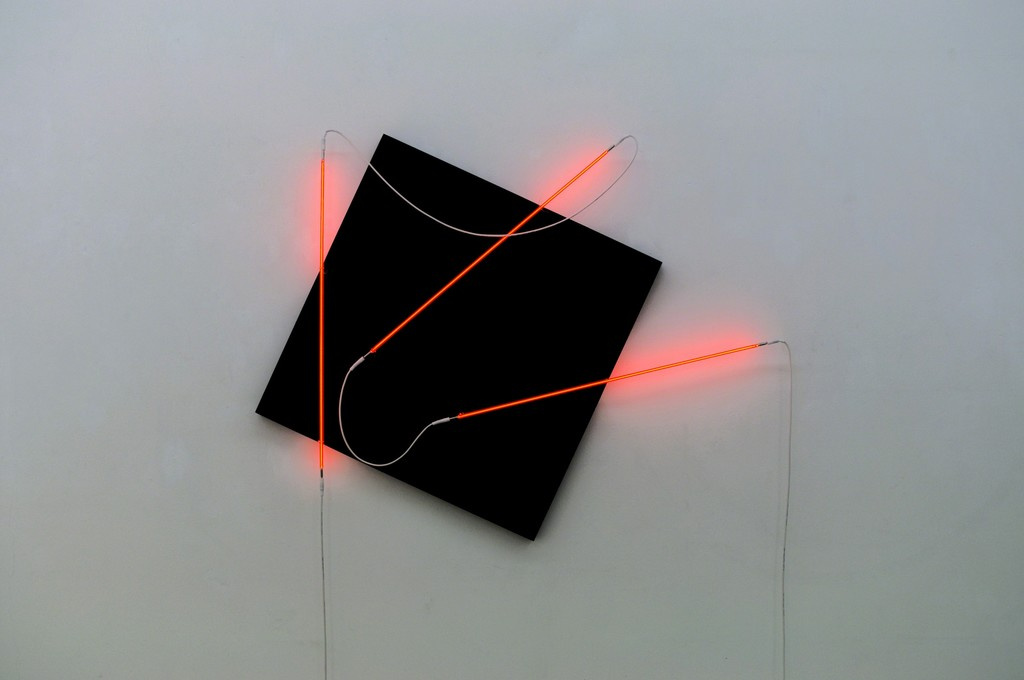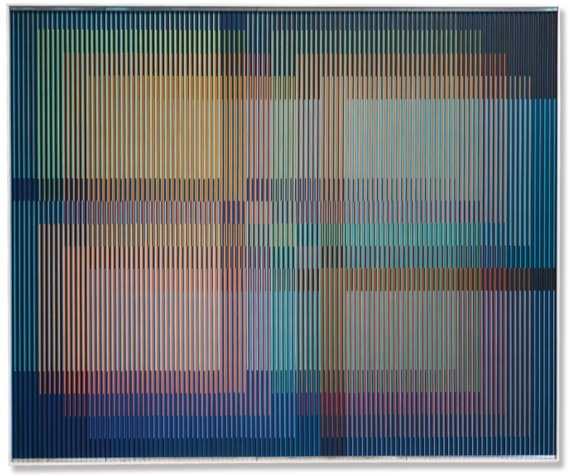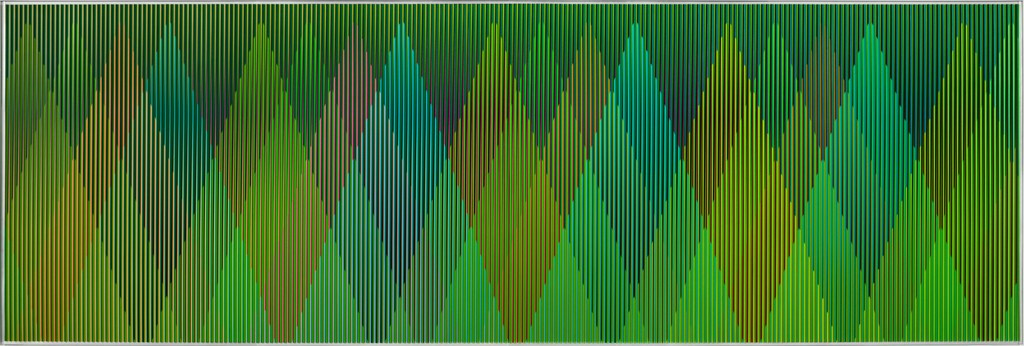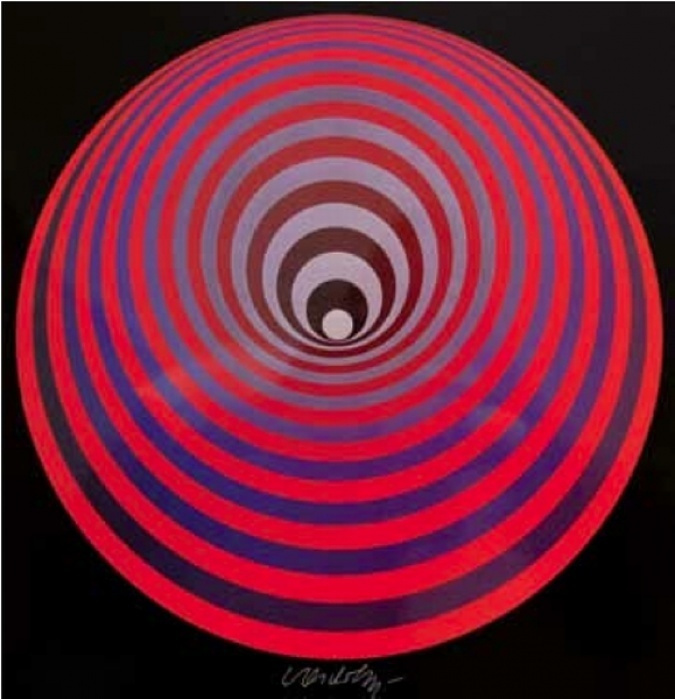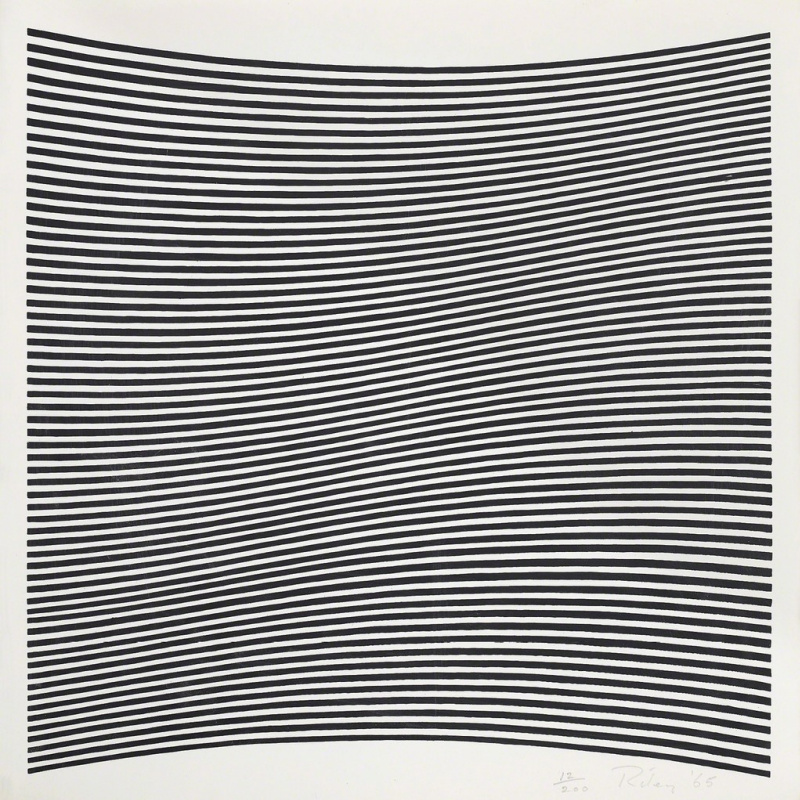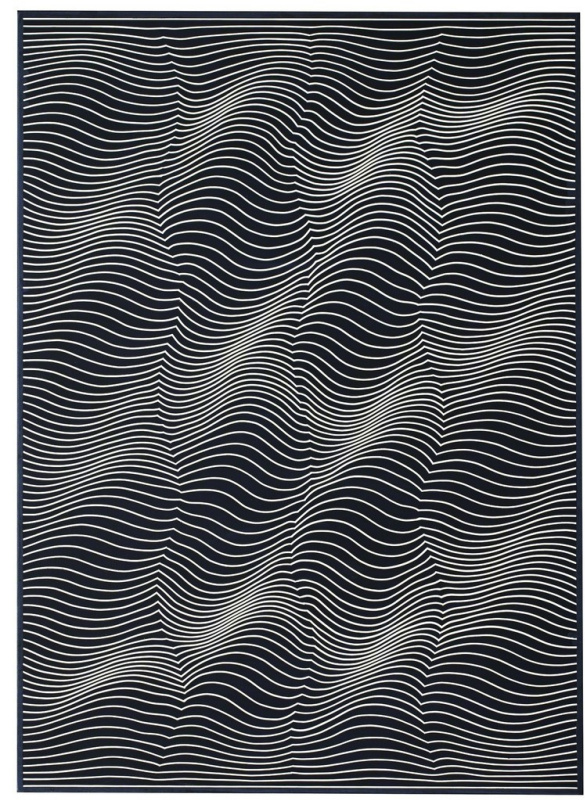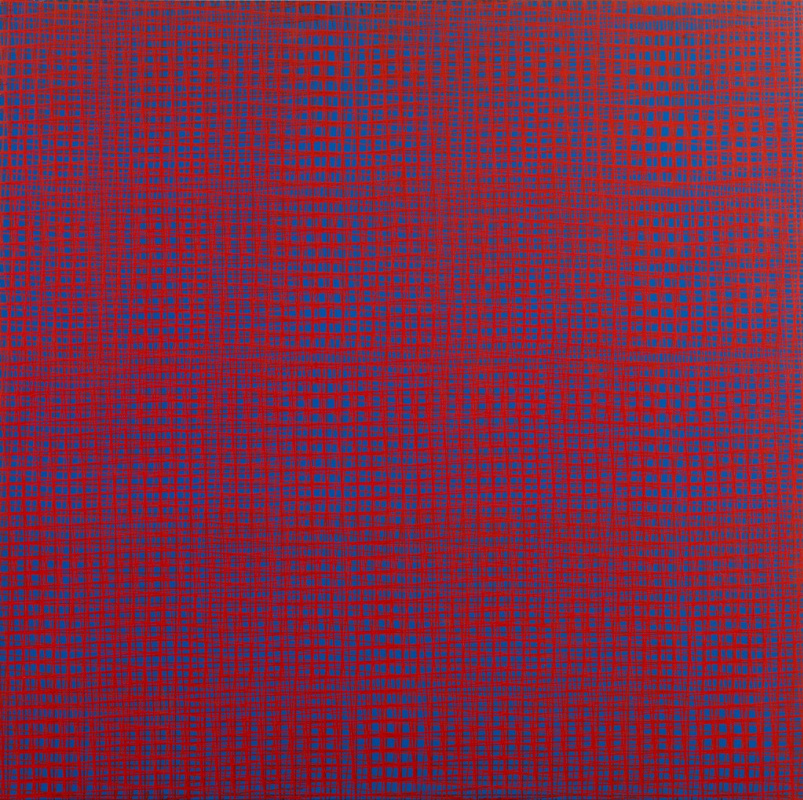Op art (optical art) is one of the branches of mid-20th-century geometric abstract art that deals with optical illusion. Representatives of this style sought to create on a flat surface the illusion of movement through the use of colour contrasts and geometric patterns. The most prominent representatives of Op art are Victor Vasarely, Bridget Riley, Julian Stanczak and Carlos Cruz-Diez.
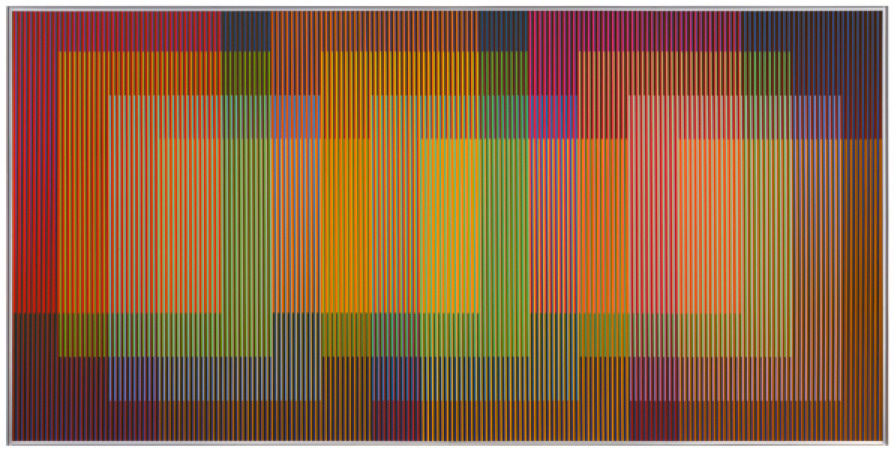
Historic moment
The appearance of Op art as an art movement is associated with the exhibition called "The Responsive Eye", which was held at the Museum of Modern Art in New York in 1965. Or, rather, it was already a moment of triumph, a rapid rise in the popularity of "illusionist" paintings. The term "op art" may have been first used in 1964 by artist and writer Donald Judd, in a review of the "Optical Paintings" exhibition by Julian Stanczak.
Relief with green
1970-th
, 203.2×152.4 cm
Although, the basis for the appearance of Op art was certainly laid a few centuries before, at the time when linear perspective started to be used in painting. And then the art had to go a long way from confusing trompe-l'œil paintings (French for "deceive the eye") to dizzying works by Op artists. Its appearance was influenced by Cezanne's experiments with colour, Cubists experiments with form, the abandonment of representational art entirely in the form of abstraction, simple geometric shapes of Mondrian, Kandinsky, Malevich, and the anti-art of the Dadaists. But it is believed that the simple geometry of the Bauhaus movement and Kinetic art had the strongest impact on Op artists.
Despite the fact that in 1933 the Bauhaus was closed down by the National Socialists who came to power, its ideas continued to develop in other schools, in particular in the United States and Hungary. It was in Budapest school where the "father of Op art", Victor Vasarely, got his art education. Kinetic Art, primarily taking the form of sculpture, concerned itself with the creation of real or illusory movement. Representatives of Op art decided to go further and set themselves an unusual goal: to create an illusion of movement on the two-dimensional surface of the picture.
Artists who represent the style of Op art: Victor Vasarely, Bridget Riley, Richard Anuszkiewicz, Carlos Cruz-Diez, Julian Stanczak, François Morellet, Marina Apollonio and Jesús Rafael Soto.
Untitled
1970, 65.4×45.1 cm
How does it work?
The secret of works executed in the style of Op art lies in the functional relationship between the eye’s retina (the organ that "sees" patterns) and the brain (the organ that interprets those patterns). Certain patterns cause confusion between these two organs, resulting in the perception of irrational optical effects. Generally speaking, these effects fall into two basic categories: the first category includes black and white geometric patterns, creating certain effects of movement (e.g. warping, vibration, or flashing) which can induce physical dizziness. The effect of works from the second category is based on after-images which appear after viewing pictures with certain colours, or colour-combinations.Since the appearance of Op art, neuroscientists have continued to probe the mechanisms by which the human eye responds to these mind-bending works. The notion that eyes are drawn to areas of contrast is foundational to visual neuroscience. Hard-edged boundaries between light and dark attract attention and become exaggerated through visual perception. A black circle on a white background, for example, will appear darker than the same black circle on a grey background (to scientists, this phenomenon is known as "centre/surround antagonism").

A comparative effect results from colour contrasts. Do you remember the story with the photo of the dress that caused a stir on the net? Why did some people see it black and blue, and others — white and gold? It’s all about the simultaneous contrast, an optical effect, through which a person can perceive the same colour in different ways depending on what other colours surround it. Bright colours cast a shadow of their complementary (or opposite) colour. That is why here the area surrounding the blue square acquires a yellow tint, although this colour was not used in the picture.
On the left: Carlos Cruz-Diez, Induction du Jaune Panam A (2010).
Some Op artists applied centuries-old lessons of linear perspective to their abstract compositions in order to create illusory effects. Around 1415, the architect Filippo Brunelleschi is thought to have invented linear perspective. It was the first mathematical method which succeeded in tricking the human eye. The Op artists proved this method could be applied in non-objective painting. Many works by Victor Vasarely can serve as a classic example of using the traditional perspective in Op art. It creates the illusion of depth and varying distance.
Green and orange composition
1980, 85.1×76.2 cm
The "cooperation" of neuro-scientists and artists in the field of studying visual effects turned out to be mutually beneficial. Though their experimental techniques differ radically, their conclusions are often the same. The human visual system is not a mirror for the outside world. Rather, it is capable of seeing far beyond what is actually there.
Op art and Maurits Cornelis Escher
Escher is often called either the representative or the forerunner of Op art. Indeed, few have managed to achieve the same skill in creating optical illusions. His famous staircases have long been part of mass culture: homages to them can be found, for example, in the animated series "The Simpsons" and in the films "Labyrinth" with David Bowie and "Inception" with Leonardo DiCaprio. But for the reason unknown, fine art lovers and connoisseurs often consider Escher’s lithographs worthy of only a little more attention than graphic design.
Relativity
1953, 28.2×29.4 cm
Still, during the '60s, hippies ("flower children") delighted in the "psychedelic" qualities of Escher’s work. The artist himself, apparently, was not particularly happy with such mainstream popularity. Escher turned down Mick Jagger’s request to reproduce one of his pictures on the cover of the Rolling Stones' album, as well as Stanley Kubrick’s request for help on a "fourth-dimensional film".
Circle Limit II
1959, 37.8×37.8 cm
Of course, it is the puzzling optical illusions that make Escher’s work similar to the works of Op artists. And although the lithographs of the Dutchman are devoid of geometrical non-objectivity, they were created with mathematical precision. Still, Escher’s work is too unique to be fully attributed to Op art. His work is sometimes called "a one-man art movement" because he didn’t associate himself with any of the existing genres and trends. At the same time, Escher was capable of concocting potent images with near-universal appeal — something, surely, to which most fine artists would aspire.
Balcony
1945, 29.7×23.4 cm
Micky Piller, a curator of the museum devoted to Escher’s works in the Hague, said: "At a time when abstract art was ruling the galleries, Escher fooled all of us by exploring such abstract ideas as eternity, infinity, and the impossible in apparently realistic prints that were amazingly well made. As the general public lost contact with the art world, Escher’s prints seemed simple and easy to understand."
Your crib to Op Art movement
Significant works
Dream
1966, 252×252 cm
Victor Vasarely is considered one of the progenitors of Op art for his optically complex and illusionistic paintings. The artist spent many years seeking for an engaging, accessible visual language that could be universally understood. This language, for Vasarely, was geometric abstraction. Through precise combinations of lines, geometric shapes, colours, and shading, he created eye-popping paintings, full of the illusion of depth, movement, and three-dimensionality. Although the black and white images have been the most memorable works in the style of Op art, colour experiments were still extremely important for many artists. Vasarely insisted, that "pure form and pure colour can signify the world."
Flames 4
1964, 109×109 cm
Bridget Riley is an abstractionist, who gained fame after the famous exhibition "The Responsive Eye." At that time, the artist preferred black and white paintings, but starting from the late 60's Riley began working in colour. At the exhibition in 1965, her work Blaze attracted special attention. The zigzag black and white lines create the perception of a circular decent. If you look closer at the image, the alternating pattern appears to shift back and forth. The interlocking lines add depth to the form as it rhythmically curves around the centre of the page, and at some point, the viewers begin to feel that they are being dragged into the funnel.
Greatness
1970, 65.9×50.2 cm
This spectacular work can be called a vivid example of Richard Anuszkiewicz’s work. It belongs to his famous "Inward Eye" series, created in the 1970s. Anuszkiewicz is considered one of the founders of Op art, who continued the work of his teacher Josef Albers, who experimented with colour combinations. The use of bright colours and geometric patterns by Anuszkiewicz gives the impression that the figures emerge from the surface of the picture and pulsate. Anuszkiewicz summarized his approach to painting as follows: "My work is of an experimental nature and has centred on an investigation into the effects of complementary colours of full intensity when juxtaposed and the optical changes that occur as a result, and a study of the dynamic effect of the whole under changing conditions of light, and the effect of light on colour."
Maquette Sphere Lutetia
1995, 55×45×45 cm
Jesús Rafael Soto was born and raised in Venezuela, and in 1950 moved to France. He was one of the many South American artists who made an important contribution to Op and Kinetic art. In his work, Soto used industrial and synthetic materials such as nylon and steel. Soto’s artwork was also influenced by the Russian Constructivists and his contemporary artist Piet Mondrian. It is noteworthy that in his works Soto often limited himself to the Dutchman’s favourite colours: red, yellow, blue, white and black. Amazing sculptures by Soto seem fragile, ready to dissolve in the air with just one touch. He began to create similar works in the mid-1960s and remained faithful to the chosen style for the rest of his life.
Antenna
1971, 66×66 cm
Once Julian Stanczak said: "I want to fuse many colorants and their gradations into a single colour experience." In his works the artist explored the visual, psychological, and emotional resonance of colour. Julian Stanczak’s style was influenced by Josef Albersand, Russian Suprematism and Constructivism
. In the early 1960s he began to create paintings that seemed to vibrate through his use of wavy lines and contrasting colours. Later these paintings gave way to more complex compositions constructed with geometric rigidity yet softened with varying degrees of colour transparency. Shapes pulsate, colours glow, and lines shuffle and dance across Stanczak’s canvases.
Neon 3D
2015, 131×175 cm
During the 60's, François Morellet joined the Research Group of Visual Art which created installations using the non-traditional materials. Morellet rejected the idea of the individual genius-artist and adopted a stance that artists are facilitators. He said: "By the early Sixties, my friends in the Groupe de Recherche d’Art Visuel and I had become convinced that the age of painting, of canvases and sculptures had come to an end, over forever. We were passionate about modern materials that hadn’t yet been 'polluted' by traditional art. We particularly liked anything that could produce movement or light." Morellet worked primarily in neon because it combined line, light, and, when blinking, movement. The artist gave his pieces incongruous titles, using puns and palindromes, to keep them from appearing too solemn.
Physichromie 508
1970, 100×120 cm
Carlos Cruz-Diez was one of a remarkable generation of South American artists who enriched European art. He spent his entire professional life between his native Caracas and Paris. The artist began to focus on the physical properties of colour after viewing the work of Jesus Rafael Soto. Cruz-Diez created a technique called "additive colour" that used evenly spaced coloured card strips. Each strip was placed parallel to the next one to create the impression of softly modulated tones, which changed according to the position of the viewer. Here Cruz-Diez used teacher Joannes Itten’s theory of the simultaneous perception of different colours. The illusion of a moving image was created by parallel line placement, linear shock, and the fusion of tonalities.
You are an expert if you: understand that the appearance of Op art was a logical consequence of centuries-old transformations in the visual arts and an indispensable stage in its development.
You are a layman if you: believe that real art is landscapes, portraits and still lifes while creating Op art picture requires only a ruler and a pair of compasses.
You are a layman if you: believe that real art is landscapes, portraits and still lifes while creating Op art picture requires only a ruler and a pair of compasses.
Phsyichromie Panam 122
2013, 80×240 cm
By the way, the representatives of Op art had a very different attitude towards the commercialization of their work. Victor Vasarely, for example, believed that art should be accessible to everyone, and he even collaborated with textile companies. And Bridget Riley didn’t like the fact that her original works were used without permission and replicated. Once, the artist saw in the shop windows on Madison Avenue dresses with patterns copied from her paintings. Angry Riley said that the use of her paintings as the basis of a fabric design "vulgarized" her art, and even made a botched attempt at suing the manufacturer.








